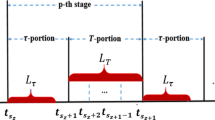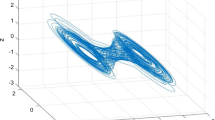Abstract
The problem of output feedback optimal control of the partially-unknown nonlinear systems with constrained-input is investigated in this paper. Firstly, a neural network observer is proposed to estimate the unmeasurable system states. Secondly, synchronous integral reinforcement learning (SIRL) algorithm is used to solve the Hamilton–Jacobi–Bellman (HJB) equation associated with non-quadratic cost function and the optimal controller is obtained without knowing the system drift dynamics. This algorithm is implemented by a critic-actor structure and the novel weight update laws of the neural networks are designed and tuned simultaneously. Moreover, the weight estimation errors of all neural networks are proven uniformly ultimately bounded (UUB), and the stability of the whole closed-loop system is also guaranteed. Finally, two numerical simulation examples support the effectiveness of the proposed methods.















Similar content being viewed by others
References
Lewis FL, Vrabie DL, Syrmos VL (2012) Optimal control, 3rd edn. Wiley & Sons, Hoboken
Wu YY, Cao JD, Alofi A, Al-Mazrooei A, Elaiw A (2015) Finite-time boundedness and stabilization of uncertain switched neural networks with time-varying delay. Neural Netw 69:135–143
Wu YY, Cao JD, Li QB, Alsaedi A, Alsaadi FE (2017) Finite-time synchronization of uncertain coupled switched neural networks under asynchronous switching. Neural Netw 85:128–139
Wang QL, Psillakis HE, Sun CY (2018) Cooperative control of multiple agents with unknown high-frequency gain signs under unbalanced and switching topologies. IEEE Trans Autom Control. https://doi.org/10.1109/TAC.2018.2867161
Wang QL, Sun CY (2018) Adaptive consensus of multi-agent systems with unknown high-frequency gain signs under directed graphs. IEEE Trans Syst Man Cybern Syst. https://doi.org/10.1109/TSMC.2018.2810089
Li QB, Guo J, Sun CY, Wu YY, Ding ZT (2018) Finite-time synchronization for a class of dynamical complex networks with nonidentical nodes and uncertain disturbance. J Syst Sci Complex. https://doi.org/10.1007/s11424-018-8141-5
Werbos PJ (1977) Advanced forecasting methods for global crisis warning and models of intelligence. Gen Syst Year b 22(6):25–38
Werbos PJ (2008) ADP: the key direction for future research in intelligent control and understanding brain intelligence. IEEE Trans Syst Man Cybern Part B Cybern 38(4):898–900
Mu CX, Wang D, He HB (2017) Novel iterative neural dynamic programming for data-based approximate optimal control design. Automatica 81:240–252
Bertsekas DP, Tsitsiklis JN (1996) Neuro-dynamic programming. Athena Sci 27(6):1687–1692
Pardalos PM (2009) Approximate dynamic programming: solving the curses of dimensionality. Wiley, New York
Si J, Wang YT (2001) Online learning control by association and reinforcement. IEEE Trans Neural Netw 12(2):264–276
Fang X, Zheng DZ, He HB, Ni Z (2015) Data-driven heuristic dynamic programming with virtual reality. Neurocomputing 166(C):244–255
Ding CX, Sun Y, Zhu YG (2017) A NN-based hybrid intelligent algorithm for a discrete nonlinear uncertain optimal control problem. Neural Process Lett 45:457–473
Wang D, Liu DR (2013) Neural-optimal control for a class of unknown nonlinear dynamic systems using SN-DHP technique. Neurocomputing 121:218–225
Zhang HG, Qin CB, Luo YH (2014) Nerual-network-based constrained optimal control scheme for discrete-time switched systems using dual heuristic programming. IEEE Trans Autom Sci Eng 121(8):839–849
Ni Z, He HB, Zhao DB, Xu X, Prokhorov DV (2014) GrDHP: a general utility function representation for dual heuristic dynamic programming. IEEE Trans Neural Netw Learn Syst 121(8):839–849
Werbos PJ (1992) Approximate dynamic programming for real-time control and neural modeling. Handbook of intelligent control. Van Nostrand, New York, pp 493–525
Werbos PJ (1990) Consistency of HDP applied to a simple reinforcement learning problem. Neural Netw 3(2):179–189
Murray JJ, Cox CJ, Lendaris GG, Saeks R (2002) Adaptive dynamic programming. IEEE Trans Syst Man Cybern 32(2):140–153
Lee JY, Park JB, Choi YH (2012) Integral Q-learning and explorized policy iteration for adaptive optimal control of continuous-time linear systems. Automatica 48(11):2850–2859
Jiang Y, Jiang ZP (2012) Computational adaptive optimal control for continuous-time linear systems with completely unknown dynamics. Automatica 48(10):2699–2704
Liu DR, Wei QL (2014) Policy iteration adaptive dynamic programming algorithm for discrete-time nonlinear systems. IEEE Trans Neural Netw Learn Syst 25(3):621–634
Mu CX, Sun CY, Wang D, Song AG (2017) Adaptive tracking control for a class of continuous-time uncertain nonlinear systems using the approximate solution of HJB equation. Neurocomputing 260:432–442
Abu-Khalaf M, Lewis FL (2005) Nearly optimal control laws for nonlinear systems with saturating actuators using a neural network HJB approach. Automatica 41(5):779–791
Vrabie D, Lewis FL (2008) Adaptive optimal control algorithm for continuous-time nonlinear systems based on policy iteration. IEEE Proc CDC08:73–79
Vrabie D, Pastravanu O, Abu-Khalaf M, Lewis FL (2009) Adaptive optimal control for continuous-time linear systems based on policy iteration. Automatica 45(2):477–484
Vrabie D, Lewis FL (2009) Neural network approach to continuous-time direct adaptive optimal control for partially unknown nonlinear systems. Neural Netw 22:237–246
Lee JY, Park JB, Choi YH (2015) Integral reinforcement learning for continuous-time input-affine nonlinear systems with simultaneous invariant explorations. IEEE Trans Neural Netw Learn Syst 26(5):916–932
Yang X, Liu DR, Luo B, Li C (2016) Data-based robust adaptive control for a class of unknown nonlinear constrained-input systems via integral reinforcement learning. Inf Sci 369:731–747
Vamvoudakis KG, Lewis FL (2010) Online actor-critic algorithm to solve the continuous-time infinite horizon optimal control problem. Automatica 46:878–888
Vamvoudakis KG, Vrabie D, Lewis FL (2014) Online adaptive algorithm for optimal control with integral reinforcement learning. Int J Robust Nonlinear Control 24:878–888
Modares H, Lewis FL, Naghibi-Sistani MB (2014) Integral reinforcement learning and experience replay for adaptive optimal control of partially-unknown constrained-input continuous-time systems. Automatica 50:193–202
Liu DR, Yang X, Wang D, Wei QL (2015) Reinforcement-learning-based robust controller design for continuous-time uncertain nonlinear systems subject to input constraints. IEEE Trans Cybern 45(7):1372–1385
Wang D, Mu CX, Zhang QC, Liu DR (2016) Event-based input-constrained nonlinear \(H_\infty \) state feedback with adaptive critic and neural implementation. Neurocomputing 214:848–856
Sun W, Wu YQ, Xia JW, Nguyen VT (2018) Adaptive fuzzy control with high-order barrier Lyapunov functions for high-order uncertain nonlinear systems with full-state constraints. IEEE Trans Cybern 99:1–9
Zhu LM, Modares H, Peen GO, Lewis FL, Yue BZ (2015) Adaptive suboptimal output-feedback control for linear systems using integral reinforcement learning. IEEE Trans Control Syst Technol 23(1):264–273
Wang TC, Sui S, Tong SC (2017) Data-based adaptive neural network optimal output feedback control for nonlinear systems with actuator saturation. Neurocomputing 247:192–201
Abdollahi F, Talebi HA, Patel RV (2006) A stable neural network-based observer with application to flexible-joint manipulators. IEEE Trans Neural Netw 17(1):118–129
Huang YZ (2017) Neuro-observer based online finite-horizon optimal control for uncertain non-linear continuous-time systems. IET Control Theory Appl 11(3):401–410
Arbib MA (2003) The handbook of brain theory and neural networks. MIT Press, Cambridge
Yan MM, Qiu JL, Chen XY, Chen X, Yang CD, Zhang AC (2018) Almost periodic dynamics of the delayed complex-valued recurrent neural networks with discontinuous activation functions. Neural Comput Appl 30:3339–3352
Yan MM, Qiu JL, Chen XY, Chen X, Yang CD, Zhang AC, Alsaadi F (2018) Almost periodic dynamics of the delayed complex-valued recurrent neural networks with discontinuous activation functions. Neural Process Lett 48:577–601
Ioannou P, Fidan B (2006) Advances in design and control. SIAM Adaptive Control Tutorial. SIAM, PA
Stevens BL, Frank FL (2003) Aircraft control and simulation. Wiley, New York
Author information
Authors and Affiliations
Corresponding author
Additional information
Publisher's Note
Springer Nature remains neutral with regard to jurisdictional claims in published maps and institutional affiliations.
This work was supported by National Natural Science Foundation of China under Grant 61473202, 61773284.
Rights and permissions
About this article
Cite this article
Ren, L., Zhang, G. & Mu, C. Optimal Output Feedback Control of Nonlinear Partially-Unknown Constrained-Input Systems Using Integral Reinforcement Learning. Neural Process Lett 50, 2963–2989 (2019). https://doi.org/10.1007/s11063-019-10072-2
Published:
Issue Date:
DOI: https://doi.org/10.1007/s11063-019-10072-2




